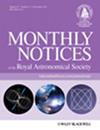CXOU J005245.0-722844: Discovery of a be star / white dwarf binary system in the SMC via a very fast, super-eddington X-ray outburst event
IF 4.8
3区 物理与天体物理
Q1 ASTRONOMY & ASTROPHYSICS
引用次数: 0
Abstract
CXOU J005245.0-722844 is an X-ray source in the Small Magellanic Cloud (SMC) that has long been known as a Be/X-ray binary (BeXRB) star, containing an OBe main sequence star and a compact object. In this paper, we report on a new very fast X-ray outburst from CXOU J005245.0-722844. X-ray observations taken by Swift constrain the duration of the outburst to less than 16 days and find that the source reached super-Eddington X-ray luminosities during the initial phases of the eruption. The XRT spectrum of CXOU J005245.0-722844 during this outburst reveals a super-soft X-ray source, best fit by an absorbed thermal blackbody model. Optical and Ultraviolet follow-up observations from the Optical Gravitational Lensing Experiment (OGLE), Asteroid Terrestrial-impact Last Alert System (ATLAS), and Swift identify a brief ∼0.5 magnitude optical burst coincident with the X-ray outburst that lasted for less than 7 days. Optical photometry additionally identifies the orbital period of the system to be 17.55 days and identifies a shortening of the period to 17.14 days in the years leading up to the outburst. Optical spectroscopy from the Southern African Large Telescope (SALT) confirms that the optical companion is an early-type OBe star. We conclude from our observations that the compact object in this system is a white dwarf (WD), making this the seventh candidate Be/WD X-ray binary. The X-ray outburst is found to be the result of a very-fast, ultra-luminous nova similar to the outburst of MAXI J0158-744.CXOU J005245.0-722844:通过快速、超边顿X射线爆发事件发现SMC中的比星/白矮星双星系统
CXOU J005245.0-722844是小麦哲伦云(SMC)中的一个X射线源,长期以来一直被认为是一颗Be/X射线双星(BeXRB),其中包含一颗OBe主序星和一颗紧凑天体。在本文中,我们报告了来自 CXOU J005245.0-722844 的新的极快 X 射线爆发。由 Swift 拍摄的 X 射线观测数据将爆发持续时间限制在 16 天以内,并发现该星源在爆发初期达到了超爱丁顿 X 射线光度。这次爆发期间 CXOU J005245.0-722844 的 XRT 光谱显示出一个超软 X 射线源,与吸收热黑体模型的拟合效果最佳。来自光学引力透镜实验(OGLE)、小行星地面撞击最后警报系统(ATLAS)和雨燕的光学和紫外线跟踪观测发现,在X射线爆发的同时,还发生了一次持续时间不到7天的∼0.5等的短暂光学爆发。光学测光还确定了该系统的轨道周期为 17.55 天,并确定在爆发前的几年里,该周期缩短到了 17.14 天。南部非洲大型望远镜(SALT)的光学光谱分析证实,这颗光学伴星是一颗早期型 OBe 星。我们通过观测得出结论,这个系统中的紧凑天体是一颗白矮星(WD),这也是第七颗候选的Be/WD X射线双星。我们发现X射线爆发是一个极快的超亮新星爆发的结果,类似于MAXI J0158-744的爆发。
本文章由计算机程序翻译,如有差异,请以英文原文为准。
求助全文
约1分钟内获得全文
求助全文
来源期刊

Monthly Notices of the Royal Astronomical Society
ASTRONOMY & ASTROPHYSICS-
CiteScore
9.10
自引率
37.50%
发文量
3198
审稿时长
3 months
期刊介绍:
Monthly Notices of the Royal Astronomical Society is one of the world''s leading primary research journals in astronomy and astrophysics, as well as one of the longest established. It publishes the results of original research in positional and dynamical astronomy, astrophysics, radio astronomy, cosmology, space research and the design of astronomical instruments.
 求助内容:
求助内容: 应助结果提醒方式:
应助结果提醒方式:


